小学英语公开课说课稿
- 格式:doc
- 大小:26.00 KB
- 文档页数:3
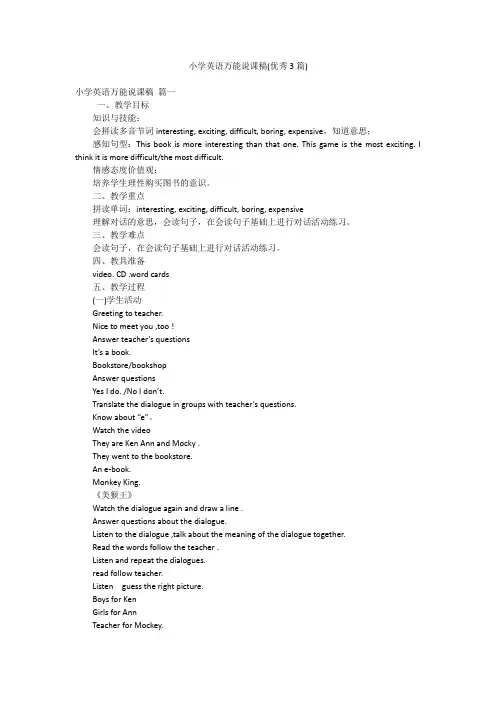
小学英语万能说课稿(优秀3篇)小学英语万能说课稿篇一一、教学目标知识与技能:会拼读多音节词interesting, exciting, difficult, boring, expensive,知道意思;感知句型:This book is more interesting than that one. This game is the most exciting. I think it is more difficult/the most difficult.情感态度价值观:培养学生理性购买图书的意识。
二、教学重点拼读单词:interesting, exciting, difficult, boring, expensive理解对话的意思,会读句子,在会读句子基础上进行对话活动练习。
三、教学难点会读句子,在会读句子基础上进行对话活动练习。
四、教具准备video. CD .word cards五、教学过程(一)学生活动Greeting to teacher.Nice to meet you ,too !Answer teacher’s questionsIt’s a book.Bookstore/bookshopAnswer questionsYes I do. /No I don’t.Translate the dialogue in groups with teacher’s questions.Know about “e”。
Watch the videoThey are Ken Ann and Mocky .They went to the bookstore.An e-book.Monkey King.《美猴王》Watch the dialogue again and draw a line .Answer questions about the dialogue.Listen to the dialogue ,talk about the meaning of the dialogue together.Read the words follow the teacher .Listen and repeat the dialogues.read follow teacher.Listen guess the right picture.Boys for KenGirls for AnnTeacher for Mockey.Act the story in groups.(二)教师活动一:Warming upGreetingNice to meet you!二:Language preparation1 Show a English books askWhat’s this? It’s a ________.We can buy it in _________.Do you like English book/music book/story book/ic book ?2 For the titleToday we will learn “Buying e-book”。
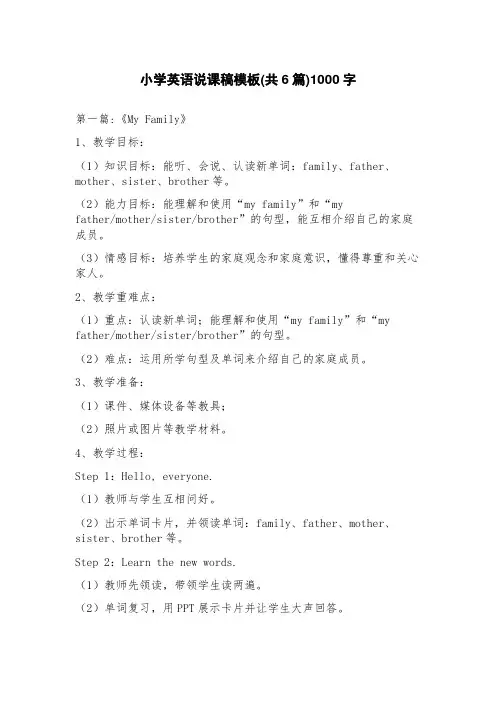
小学英语说课稿模板(共6篇)1000字第一篇:《My Family》1、教学目标:(1)知识目标:能听、会说、认读新单词:family、father、mother、sister、brother等。
(2)能力目标:能理解和使用“my family”和“myfather/mother/sister/brother”的句型,能互相介绍自己的家庭成员。
(3)情感目标:培养学生的家庭观念和家庭意识,懂得尊重和关心家人。
2、教学重难点:(1)重点:认读新单词;能理解和使用“my family”和“my father/mother/sister/brother”的句型。
(2)难点:运用所学句型及单词来介绍自己的家庭成员。
3、教学准备:(1)课件、媒体设备等教具;(2)照片或图片等教学材料。
4、教学过程:Step 1:Hello, everyone.(1)教师与学生互相问好。
(2)出示单词卡片,并领读单词:family、father、mother、sister、brother等。
Step 2:Learn the new words.(1)教师先领读,带领学生读两遍。
(2)单词复习,用PPT展示卡片并让学生大声回答。
(3)复习过后,教师出一些新单词的图片,让学生猜测单词,并引导学生说出新单词。
Step 3:Introduce my family.(1)出示自己家庭照片。
(2)教师介绍自己的家庭成员,并介绍爸爸、妈妈、姐姐、弟弟、哥哥这几个词的意思。
(3)学生模仿教师介绍自己的家庭成员,用“My family has …”或“My father/mother/sister/brother is …”进行介绍。
(4)教师给出评价和指导。
Step 4:Listen and repeat.(1)语音练习:听发音,跟读单词和句子。
(2)教师播放听力材料,学生跟读练习。
Step 5:Homework(1)写一段50字左右关于自己家庭的介绍。
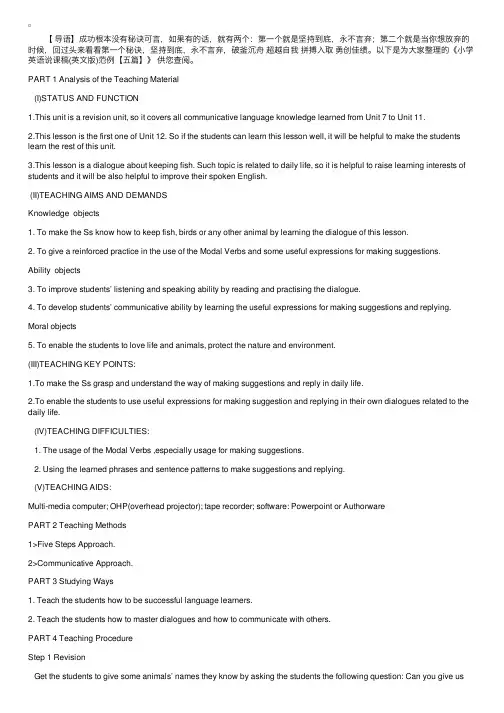
【导语】成功根本没有秘诀可⾔,如果有的话,就有两个:第⼀个就是坚持到底,永不⾔弃;第⼆个就是当你想放弃的时候,回过头来看看第⼀个秘诀,坚持到底,永不⾔弃,破釜沉⾈超越⾃我拼搏⼊取勇创佳绩。
以下是为⼤家整理的《⼩学英语说课稿(英⽂版)范例【五篇】》供您查阅。
PART 1 Analysis of the Teaching Material(I)STATUS AND FUNCTION1.This unit is a revision unit, so it covers all communicative language knowledge learned from Unit 7 to Unit 11.2.This lesson is the first one of Unit 12. So if the students can learn this lesson well, it will be helpful to make the students learn the rest of this unit.3.This lesson is a dialogue about keeping fish. Such topic is related to daily life, so it is helpful to raise learning interests of students and it will be also helpful to improve their spoken English.(II)TEACHING AIMS AND DEMANDSKnowledge objects1. To make the Ss know how to keep fish, birds or any other animal by learning the dialogue of this lesson.2. To give a reinforced practice in the use of the Modal Verbs and some useful expressions for making suggestions.Ability objects3. To improve students’ listening and speaking ability by reading and practising the dialogue.4. To develop students’ communicative ability by learning the useful expressions for making suggestions and replying. Moral objects5. To enable the students to love life and animals, protect the nature and environment.(III)TEACHING KEY POINTS:1.To make the Ss grasp and understand the way of making suggestions and reply in daily life.2.To enable the students to use useful expressions for making suggestion and replying in their own dialogues related to the daily life.(IV)TEACHING DIFFICULTIES:1. The usage of the Modal Verbs ,especially usage for making suggestions.2. Using the learned phrases and sentence patterns to make suggestions and replying.(V)TEACHING AIDS:Multi-media computer; OHP(overhead projector); tape recorder; software: Powerpoint or AuthorwarePART 2 Teaching Methods1>Five Steps Approach.2>Communicative Approach.PART 3 Studying Ways1. Teach the students how to be successful language learners.2. Teach the students how to master dialogues and how to communicate with others.PART 4 Teaching ProcedureStep 1 RevisionGet the students to give some animals’ names they know by asking the students the following question: Can you give ussome names of different animals you know? This step is employed to revise the words related the animals. At the same time draw the students’ attention to the topic about animals.Step 2 Lead-inSign to the students to be quiet and close their books. Then start a free talk with the students. Use computer to show some pictures of different pets, such as dogs, cats etc. Ask the students several questions about raising pets. These questions are employed to warm up the students and raise the interests of the students to speak English in class on the topics they like and familiar with.Good morning, everyone!Today, I’ll say something about Unit 9 Part A in Book 4 of Oxford English.Background on the reformation of curriculum, this book can connect the life and act, emphasize the interest and experience of the Ss, the pictures are active and vivid. Grade four is the initial stage of English learning, so it stresses on the emotion of the Ss, creates a well beginning for the Ss. This Unit has 7 parts, we’ll learn Part A mainly, it embodies the repeating characterize. Review the learned language points “Where’s…”and the new language points will be represented in the following units. So this unit forms connecting links with a special meaning in this book.The content of this period is to use “Where’s\are…” to determine the place. And according to the contents and the fact of the Ss, I establish the following three teaching aims of this period:The first one: students can listen, read, say and spell the following words: a glass, a fridge, an egg, bread and a table.The second one: students can listen, read, say and write the following daily expressions: What’s for breakfast?Have some juice then.The third one: students can listen, read, say and write the following sentence patterns: Where’s\Where are the\my…It’s \They’re…There’s no …in \on \near…I think the most difficult point of this period is to make sure the students can use the patterns “Where’s\Where are…and There is no …in\on\near…” in their daily life correctly.And I will use some pictures, words and sentence cards, a tape recorder and the multi-media computer to help me achieve the aims.The task-based method, communicated method, group cooperate method will be used in this period.To accomplish the aims, I design the following steps:Step 1 Songs and the game arousers the emotion.In order to attract the Ss’ attention and construct an atmosphere of learning English, I let the students sing some English songs and play the game “Simon says”. At the same time the game can review the prep, serve the knowledge as foil and consist the appearance of the knowledge.Step 2 Change class to life, happy to say.The substance of language is communication and the environment of communication is life. So when I present the sentence pattern “What’s for breakfast?” I first show a clock to elicit the time for breakfast, teach the sentence. Then show my own photo of having breakfast, Ss ask and guess. In this way I can attract Ss’ attention, encourage Ss to ask Qs with the new knowledge.Most of the Ss have learnt the sentence pattern: Where’s…? so I design a task for Ss to help Helen find the food and drinks for breakfast, and teach the new language points: Where are…?They’re … Meanwhile stick the sentences on the Bb.After some practice by asking and answering, I present the next language points:There’s no …in\on\near…Have …then.And I will stick these sentence patterns on the Bb. Finally I’ll let the Ss do pair works to consolidate them.Step 3 Listen to the tape and Ss imitate to read and say.As the new reformation of curriculum, emphasized the traditional class attach importance to the mechanical teaching, neglect the experience and participation, for example, the five-step method. So in this lesson, after presentation, I ask Ss to listen to the tape with three Qs, read in different roles and in pairs, then try to recite the text.Step 4 Ss be the main body, T makes a guider.In class, Ss play as a host, and the T makes an influence on guiding, help Ss to act the learnt dialogue, it can stress the position of the Ss, and arouse their interest.Then I show a carton with no voice, ask Ss to make a dialogue in pairs.There are lots of ways to consolidate the new knowledge. Playing game is a good way. So according to the physiology of Ss, I hold a group competition during the game, ask Ss to finish the blanks. In this way can develop Ss’ good habits and achieve the aim of mastering the learned knowledge in situation.Step 5 Change class to life, learn by themselves.Is this the end of the class? I don’t think so. If there is an end, I think it should be in the life. So I extend this class, encourage Ss to use the learned to communicate with each other in their life.In a word, the whole period is based on tasks, which are designed from easy steps to steps that are challenging. When the Ss are carting out the tasks, they can acquire information, knowledge, and have their ability and skills trained.Thank you!。
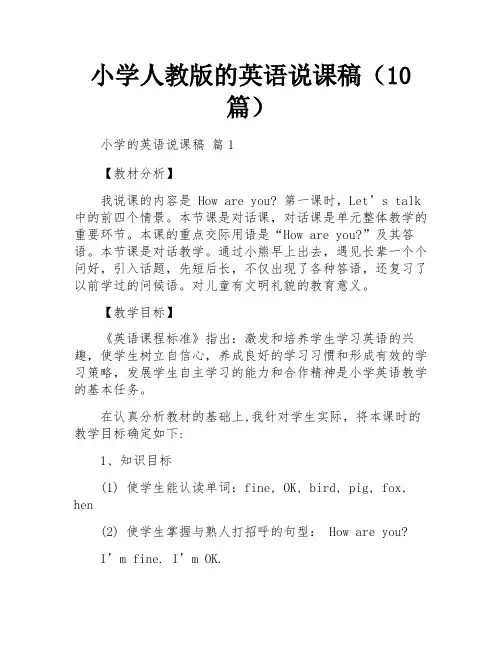
小学人教版的英语说课稿(10篇)小学的英语说课稿篇1【教材分析】我说课的内容是 How are you? 第一课时,Let’s talk 中的前四个情景。
本节课是对话课,对话课是单元整体教学的重要环节。
本课的重点交际用语是“How are you?”及其答语。
本节课是对话教学。
通过小熊早上出去,遇见长辈一个个问好,引入话题,先短后长,不仅出现了各种答语,还复习了以前学过的问候语。
对儿童有文明礼貌的教育意义。
【教学目标】《英语课程标准》指出:激发和培养学生学习英语的兴趣,使学生树立自信心,养成良好的学习习惯和形成有效的学习策略,发展学生自主学习的能力和合作精神是小学英语教学的基本任务。
在认真分析教材的基础上,我针对学生实际,将本课时的教学目标确定如下:1、知识目标(1) 使学生能认读单词:fine, OK, bird, pig, fox, hen(2) 使学生掌握与熟人打招呼的句型: How are you?I’m fine. I’m OK.Thank you. And you?2、语言技能目标:在图文或场景下进行简单的英语交流和表演,培养学生灵活运用所学知识进行交流的能力.3、情感态度目标通过本课的学习,学生对英语听说感兴趣,背诵歌谣,做游戏,敢说,乐于模仿,在鼓励评价中树立自信。
在小组活动中积极参与合作,从而认识到交流在英语学习中的重要性。
4、文化意识目标:能够恰当使用英语中与人问好的问候语,了解在英语国家中熟人见面相互打招呼的方式。
对学生进行日常行为礼貌教育。
【教学重点难点】教学重点:见面问好的句型:How are you? 和他的各种回答方法由简单的回答到复杂的回答及反问。
教学难点:(1)How are you? 与How do you do? Nice to meet you. 等问候语的用法区别。
(2)培养学生的合作学习能力。
同时,注意培养学生学习英语的兴趣,树立自信心。
【教学准备】老师准备课件,各种动物头饰,录音机,磁带,小红花,小组评价表。
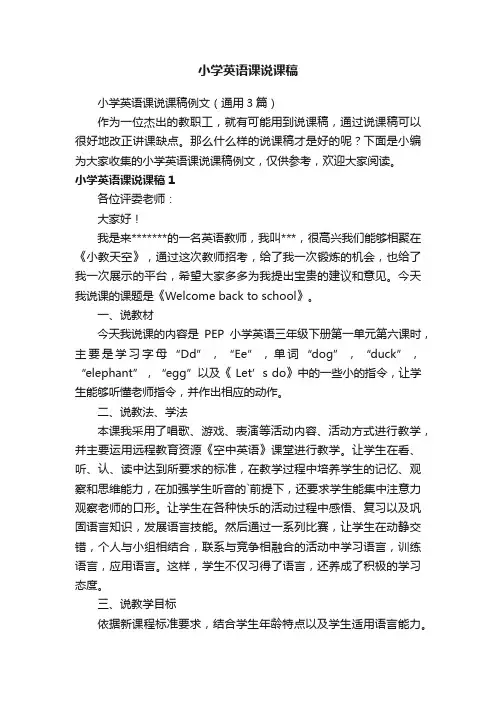
小学英语课说课稿小学英语课说课稿例文(通用3篇)作为一位杰出的教职工,就有可能用到说课稿,通过说课稿可以很好地改正讲课缺点。
那么什么样的说课稿才是好的呢?下面是小编为大家收集的小学英语课说课稿例文,仅供参考,欢迎大家阅读。
小学英语课说课稿1各位评委老师:大家好!我是来*******的一名英语教师,我叫***,很高兴我们能够相聚在《小教天空》,通过这次教师招考,给了我一次锻炼的机会,也给了我一次展示的平台,希望大家多多为我提出宝贵的建议和意见。
今天我说课的课题是《Welcome back to school》。
一、说教材今天我说课的内容是PEP小学英语三年级下册第一单元第六课时,主要是学习字母“Dd”,“Ee”,单词“dog”,“duck”,“elephant”,“egg”以及《Let’s do》中的一些小的指令,让学生能够听懂老师指令,并作出相应的动作。
二、说教法、学法本课我采用了唱歌、游戏、表演等活动内容、活动方式进行教学,并主要运用远程教育资源《空中英语》课堂进行教学。
让学生在看、听、认、读中达到所要求的标准,在教学过程中培养学生的记忆、观察和思维能力,在加强学生听音的`前提下,还要求学生能集中注意力观察老师的口形。
让学生在各种快乐的活动过程中感悟、复习以及巩固语言知识,发展语言技能。
然后通过一系列比赛,让学生在动静交错,个人与小组相结合,联系与竞争相融合的活动中学习语言,训练语言,应用语言。
这样,学生不仅习得了语言,还养成了积极的学习态度。
三、说教学目标依据新课程标准要求,结合学生年龄特点以及学生适用语言能力。
第六课时的教学目标是:1、通过远程教育资源以及其他不同方式要求学生学会“Dd”,“Ee”两个字母以及“dog”,“duck”,“elephant”,“egg”的正确认读。
2、以培养学生兴趣为根本出发点,运用《Let’s do》部分提高学生兴趣,让学生在玩中学,学中用。
3、培养学生积极主动学习以及运用语言的能力,提高他们的竞争意识,让学生在竞争中体现合作意识。
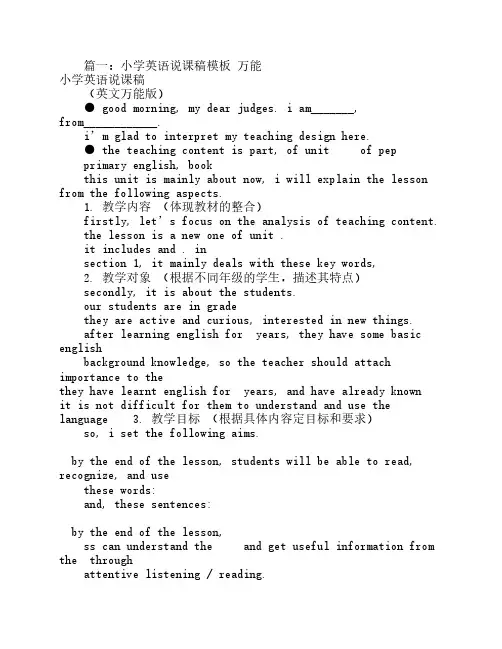
篇一:小学英语说课稿模板 万能小学英语说课稿(英文万能版)● good morning, my dear judges. i am_______,from____________.i’m glad to interpret my teaching design here.● the teaching content is part, of unit of pepprimary english, bookthis unit is mainly about now, i will explain the lesson from the following aspects.1. 教学内容 (体现教材的整合)firstly, let’s focus on the analysis of teaching content. the lesson is a new one of unit .it includes and . insection 1, it mainly deals with these key words,2. 教学对象 (根据不同年级的学生,描述其特点)secondly, it is about the students.our students are in gradethey are active and curious, interested in new things.after learning english for years, they have some basic englishbackground knowledge, so the teacher should attach importance to thethey have learnt english for years, and have already known it is not difficult for them to understand and use the language 3. 教学目标 (根据具体内容定目标和要求)so, i set the following aims.by the end of the lesson, students will be able to read, recognize, and usethese words:and, these sentences:by the end of the lesson,ss can understand the and get useful information from the throughattentive listening / reading.ss are able to talk about ss can use to give suggestions onss’ abilities of listening and speaking will be developed.(affect; learning strategies; cultural awareness.)in this lesson, the emotional aim isto help students cultivate and foster their abilities of working ingroups.to foster ss’ consciousness of good-cooperation and properto help ss cultivate their abilities to analyze and solve problemsindependently.to foster ss’ initiative and creativeness.to make sure that ss can use correctlyskillfully.to develop ss’ interest in english.the difficult point is:the pronunciation of 教法学法fourthly, it talks about teaching methods.andin this lesson, i will mainly use “task-based teaching method”,and so on.4. 教学过程① 具体steps 根据具体内容定;② 板书steps + purpose 说明;③ 如有可能,同时完成layout设计;next, let’s focus on the teaching procedures.i will finish the lesson in steps.it will cost about mins.after greeting with the ss, i will begin the lesson by singing the song together with the ss.purpose:the purpose of this is to form a better english learning surrounding forthe ss, and, at the same time, it provides situations to review the learntknowledgefor the next step.it will cost about mins.with the help of the ppt, i set a situation of by to stimulate the ss’ interest of the lesson.by playing the ppt, iand then, (板书layout)the purpose of this is to present the new words and sentences in thesituation, which relates to the ss’ real life experiences, to help the ssunderstand the language easily and naturally.after presenting each new word (by the guessing game), i will impart theknowledge of pronunciation rules in teaching the new words.it is called phonics.it can facilitate the ss’ abilities to pronounce the words, and help them toremember the spelling of the words.(机械上口; 有意义操练; let’s do; 课文对话表演;)it will cost mins, includingdue to the ss’ age, i make the purpose of this is to draw the whole ss’ attention to the spelling ofthe words.it is to help ss to learn through a true situation. in this step, i will give ss a free space to show their abilities.i willthen,used here.ability of cooperation will be well developed.making a new dialogue is to check if ss can use correctly and skillfully.(总结上课内容; 德育渗透; 作业布置;)in this step, i will guide the ss to conclude the key words and sentencesand also, i will the purpose of this is to stimulate ss’ interest of learning english and5. 板书设计and, this is my layout design.that’s all for my teaching design. thank you a lot for listening. (gong)篇二:小学英语说课稿:《what do you like》说课稿范文小学英语说课稿:《what do you like》unit 11 what do you like?说课稿1.说教材1.1教材内容本节教材的主要话题是food,功能为运用i like?.句型表达自己喜好什么食物,并在此基础上进行简单的语言交流。
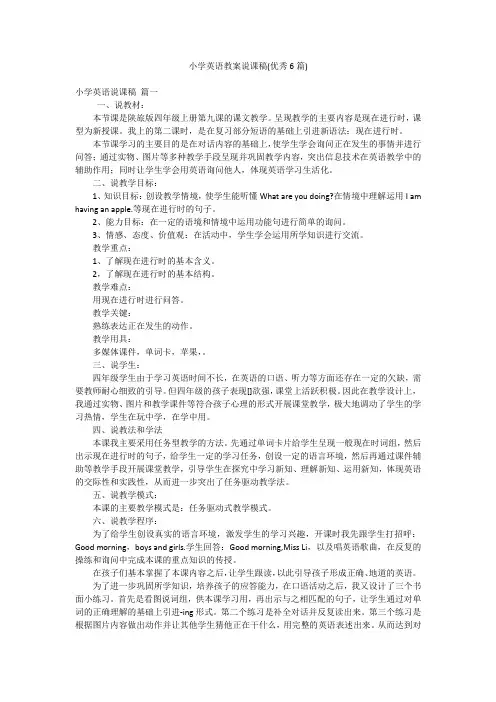
小学英语教案说课稿(优秀6篇)小学英语说课稿篇一一、说教材:本节课是陕旅版四年级上册第九课的课文教学。
呈现教学的主要内容是现在进行时,课型为新授课。
我上的第二课时,是在复习部分短语的基础上引进新语法:现在进行时。
本节课学习的主要目的是在对话内容的基础上,使学生学会询问正在发生的事情并进行问答;通过实物、图片等多种教学手段呈现并巩固教学内容,突出信息技术在英语教学中的辅助作用;同时让学生学会用英语询问他人,体现英语学习生活化。
二、说教学目标:1、知识目标:创设教学情境,使学生能听懂What are you doing?在情境中理解运用I am having an apple.等现在进行时的句子。
2、能力目标:在一定的语境和情境中运用功能句进行简单的询问。
3、情感、态度、价值观:在活动中,学生学会运用所学知识进行交流。
教学重点:1、了解现在进行时的基本含义。
2,了解现在进行时的基本结构。
教学难点:用现在进行时进行问答。
教学关键:熟练表达正在发生的动作。
教学用具:多媒体课件,单词卡,苹果,。
三、说学生:四年级学生由于学习英语时间不长,在英语的口语、听力等方面还存在一定的欠缺,需要教师耐心细致的引导。
但四年级的孩子表现[]欲强,课堂上活跃积极。
因此在教学设计上,我通过实物、图片和教学课件等符合孩子心理的形式开展课堂教学,极大地调动了学生的学习热情,学生在玩中学,在学中用。
四、说教法和学法本课我主要采用任务型教学的方法。
先通过单词卡片给学生呈现一般现在时词组,然后出示现在进行时的句子,给学生一定的学习任务,创设一定的语言环境,然后再通过课件辅助等教学手段开展课堂教学,引导学生在探究中学习新知、理解新知、运用新知,体现英语的交际性和实践性,从而进一步突出了任务驱动教学法。
五、说教学模式:本课的主要教学模式是:任务驱动式教学模式。
六、说教学程序:为了给学生创设真实的语言环境,激发学生的学习兴趣,开课时我先跟学生打招呼:Good morning,boys and girls.学生回答:Good morning,Miss Li,以及唱英语歌曲,在反复的操练和询问中完成本课的重点知识的传授。
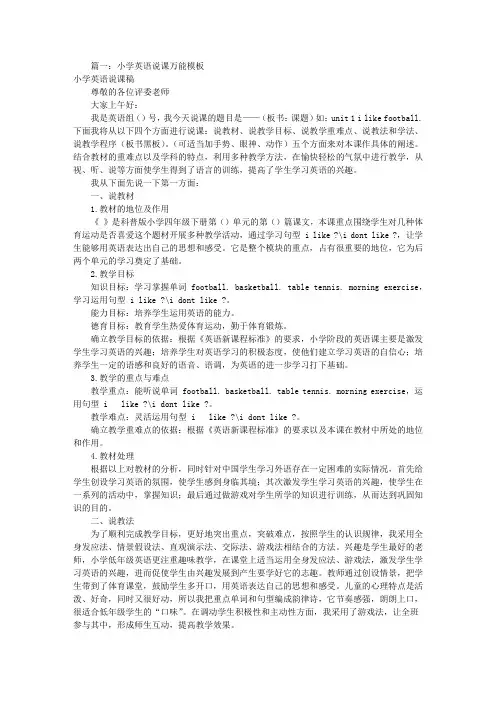
篇一:小学英语说课万能模板小学英语说课稿尊敬的各位评委老师大家上午好:我是英语组()号,我今天说课的题目是——(板书:课题)如:unit 1 i like football.下面我将从以下四个方面进行说课:说教材、说教学目标、说教学重难点、说教法和学法、说教学程序(板书黑板)。
(可适当加手势、眼神、动作)五个方面来对本课作具体的阐述。
结合教材的重难点以及学科的特点,利用多种教学方法,在愉快轻松的气氛中进行教学,从视、听、说等方面使学生得到了语言的训练,提高了学生学习英语的兴趣。
我从下面先说一下第一方面:一、说教材1.教材的地位及作用《》是科普版小学四年级下册第()单元的第()篇课文,本课重点围绕学生对几种体育运动是否喜爱这个题材开展多种教学活动,通过学习句型 i like ?\i dont like ?,让学生能够用英语表达出自己的思想和感受。
它是整个模块的重点,占有很重要的地位,它为后两个单元的学习奠定了基础。
2.教学目标知识目标:学习掌握单词 football. basketball. table tennis. morning exercise,学习运用句型 i like ?\i dont like ?。
能力目标:培养学生运用英语的能力。
德育目标:教育学生热爱体育运动,勤于体育锻炼。
确立教学目标的依据:根据《英语新课程标准》的要求,小学阶段的英语课主要是激发学生学习英语的兴趣;培养学生对英语学习的积极态度,使他们建立学习英语的自信心;培养学生一定的语感和良好的语音、语调,为英语的进一步学习打下基础。
3.教学的重点与难点教学重点:能听说单词 football. basketball. table tennis. morning exercise,运用句型 i like ?\i dont like ?。
教学难点:灵活运用句型 i like ?\i dont like ?。
确立教学重难点的依据:根据《英语新课程标准》的要求以及本课在教材中所处的地位和作用。
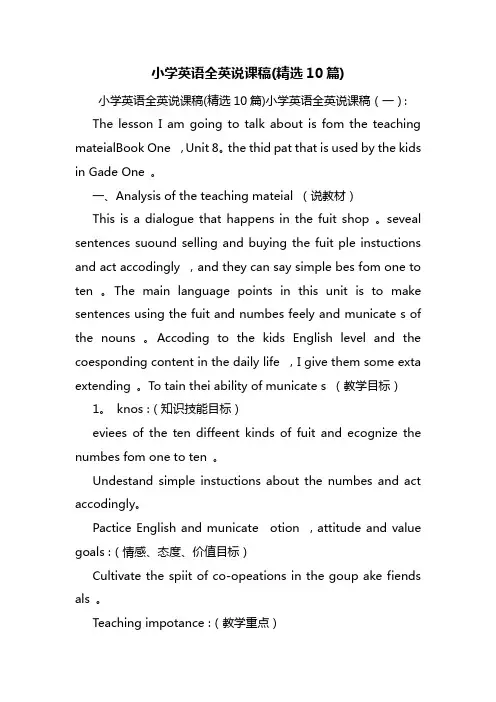
小学英语全英说课稿(精选10篇)小学英语全英说课稿(精选10篇)小学英语全英说课稿(一):The lesson I am going to talk about is fom the teaching mateialBook One ,Unit 8。
the thid pat that is used by the kids in Gade One 。
一、Analysis of the teaching mateial (说教材)This is a dialogue that happens in the fuit shop 。
seveal sentences suound selling and buying the fuit ple instuctions and act accodingly ,and they can say simple bes fom one to ten 。
The main language points in this unit is to make sentences using the fuit and numbes feely and municate s of the nouns 。
Accoding to the kids English level and the coesponding content in the daily life ,I give them some exta extending 。
To tain thei ability of municate s (教学目标)1。
knos :(知识技能目标)eviees of the ten diffeent kinds of fuit and ecognize the numbes fom one to ten 。
Undestand simple instuctions about the numbes and act accodingly。

【导语】⼀份优秀的说课稿,体现的不仅仅是教师的能⼒,更体现出教师对⼯作的热爱认真程度,通过说课稿,教师可以更好地展开教学,合理科学的规划使教学作⽤化。
以下是整理的《⼩学⽣英语说课稿(三篇)》相关资料,希望帮助到您。
【篇⼀】⼩学⽣英语说课稿 ⼀、说教材 各位⽼师,⼤家好!今天我说课的内容是⼈教版⼩学英语PEP教材四年级上册Unit 3 My friends中的第⼀课时,本课时的主要内容是Let's learn 部分。
本课的主要内容是学习新单词: long hair,short hair,thin,strong,quiet 和friends,会运⽤句型My friend has short hair/long hair; My friend is quiet/strong/thin. 本单元围绕“朋友”这⼀题材展开,使学⽣能⽤英语简单的介绍⾃⼰的朋友。
⼆、说教学⽬标和教学重难点 1、说教学⽬标 新英语课程标准指出,基础教育阶段英语课程的总⽬标是培养学⽣的综合语⾔的应⽤能⼒。
包括了学⽣的语⾔技能,情感态度,学习策略和⽂化意识⼏个⽅⾯。
根据以上要求,我将教学⽬标确定为: (1)知识⽬标:学⽣能够听,说及认读本课的新单词和long hair,short hair,thin,strong,quiet 和 friends,会运⽤句型My friend has short hair/long hair; My friend is quiet/strong/thin. (2)情感⽬标:通过本课的学习培养学⽣与朋友的关系,能更好的与朋友与同学相处,培养他们的合作能⼒和精神。
(3)技能⽬标:能让学⽣听,说认读本课的新单词及会运⽤新句型。
2、教学重难点 (1)教学重点:学⽣能够听,说及认读本课的新单词和long hair,short hair,thin,strong,quiet 和friends。
(2)教学难点:学⽣会运⽤句型My friend has short hair/long hair; My friend is quiet/strong/thin. 三、说教情和学情 1、说学情:四年级的学⽣对英语在三年级的基础上已经有了进⼀步的了解,这时对英语也产⽣了极⼤的兴趣,在已能听,说,读⽅⾯具有了⼀顶的基础。
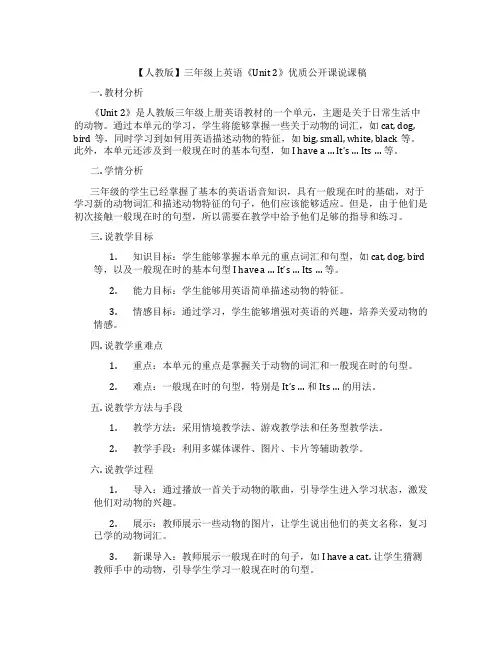
【人教版】三年级上英语《Unit 2》优质公开课说课稿一. 教材分析《Unit 2》是人教版三年级上册英语教材的一个单元,主题是关于日常生活中的动物。
通过本单元的学习,学生将能够掌握一些关于动物的词汇,如cat, dog, bird等,同时学习到如何用英语描述动物的特征,如big, small, white, black等。
此外,本单元还涉及到一般现在时的基本句型,如I have a … It’s … Its … 等。
二. 学情分析三年级的学生已经掌握了基本的英语语音知识,具有一般现在时的基础,对于学习新的动物词汇和描述动物特征的句子,他们应该能够适应。
但是,由于他们是初次接触一般现在时的句型,所以需要在教学中给予他们足够的指导和练习。
三. 说教学目标1.知识目标:学生能够掌握本单元的重点词汇和句型,如cat, dog, bird等,以及一般现在时的基本句型I have a … It’s … Its … 等。
2.能力目标:学生能够用英语简单描述动物的特征。
3.情感目标:通过学习,学生能够增强对英语的兴趣,培养关爱动物的情感。
四. 说教学重难点1.重点:本单元的重点是掌握关于动物的词汇和一般现在时的句型。
2.难点:一般现在时的句型,特别是It’s … 和Its … 的用法。
五. 说教学方法与手段1.教学方法:采用情境教学法、游戏教学法和任务型教学法。
2.教学手段:利用多媒体课件、图片、卡片等辅助教学。
六. 说教学过程1.导入:通过播放一首关于动物的歌曲,引导学生进入学习状态,激发他们对动物的兴趣。
2.展示:教师展示一些动物的图片,让学生说出他们的英文名称,复习已学的动物词汇。
3.新课导入:教师展示一般现在时的句子,如I have a cat. 让学生猜测教师手中的动物,引导学生学习一般现在时的句型。
4.操练:学生分组,每组选择一个动物,用一般现在时的句型描述自己的动物。
5.游戏:教师准备一些动物卡片,学生轮流抽取卡片,用一般现在时的句型描述卡片上的动物。
小学英语优质说课稿小学英语优质说课稿(精选8篇)作为一名老师,通常需要用到说课稿来辅助教学,说课稿有助于教学取得成功、提高教学质量。
我们该怎么去写说课稿呢?以下是小编帮大家整理的小学英语优质说课稿,希望能够帮助到大家。
小学英语优质说课稿篇1一、说教学内容今天我说课的内容是人民教育出版社出版的PEP Primary English Book IV Unit 6 At a Farm.的第一课时,主要学习sheep, lamb, goat, cow, horse, hen六个新词..二、说教材本节课是单词教学。
它是在孩子初步学习了句型“How many……do you have?之后进行教学的。
通过学习新词,感知句子What are they? They are….How many….为下节课的教学打下基础。
本课时容量大,但难度不大,并受到孩子的喜爱.三、说教学目标《英语课程标准》指出:激发和培养孩子学习英语的兴趣,使孩子树立自信心,养成良好的学习习惯和形成有效的学习策略,发展孩子自主学习的能力和合作精神是小学英语教学的基本任务。
在认真分析教材的基础上,我针对孩子实际,将本课时的教学目标及重,难点确定如下:1、知识目标(1)使孩子能听、说、认、读sheep, lamb, goat, cow, horse, hen等单词。
(2)初步感知:“What are they? They are…. How many….How many……”等句子孩子能听懂并理解其意思。
2、能力目标:(1) 能听懂Let’s do中的指令并做出相应动作.,如Shear a sheep.(2) 能区分农场的动物, 培养孩子灵活运用所学知识进行交流的能力.3、情感目标(1)培养孩子注意观察、认真模仿的良好习惯和主动竞争的竟识。
(2)激发孩子学习英语的兴趣,使孩子树立学习英语的自信心。
(3)培养孩子的合作交流能力。
四、说教学重点学习新词sheep, lamb, goat, cow, horse, hen, 能正确认读.。
小学英语说课稿范文3篇小学英语说课稿范文3篇作为一位优秀的人民教师,总不可避免地需要编写说课稿,借助说课稿我们可以快速提升自己的教学能力。
说课稿要怎么写呢?下面是精心的小学英语说课稿范文,仅供参考,希望能够帮助到大家。
1.教材内容本节教材重点围绕节日展开,围绕人们经常如何度过节日展开话题。
本课时要求学生能掌握四个节日National Day, Halloween, Christmas, Spring Festival 及句型What do people usually do at ?.? I? .并能自由交流如何度过假日。
在本课中did引导的一般疑问句及回答也是新知之一。
因为在前面第三单元己出现了be 动词的过去式,所以学生在学习的时候这方面比较容易掌握。
2.教材的地位本节课所选的教学内容是牛津小学英语6A Unit 6。
本单元教学围绕节日展开。
在询问节日这部分,学生已有了前面第三单元的知识铺垫,比较易于深入与扩展。
这样的安排,既体现了教材循序渐进、由难到易的编排意思,又符合学生的知识水平和认知水平。
关于人们如何度过节日这一话题,特别是西方的节日,。
则需要学生课后及时收集资料。
在实际教学中,本课采用旧话题先教新句型,再用句型引新知的方式展开,这样既便于学生接受掌握,也体现了教学内容之间的连贯性。
1.教学目标新课程强调知识与技能、过程与方法、情感态度与价值观三个角度的有机结合,本着这样的认识,我制定如下教学目标。
[认知目标]学生能听、说、读短语及单词:visit relatives and friends , go to parties, dress up in costumes, ware masks , make pumping lanterns, eat lots of delicious food , National Day, Christmas, Halloween, Spring Festival , favourite ; 能运用 When’s ...? What do people usually do at ?? Did you?.last ?? Yes , I did./ No, I didn’t.等进行口语交际。
【人教版】小学三年级上英语《Unit 3 》优质精品公开课说课稿一. 教材分析《人教版》小学三年级上英语《Unit 3》的主题是关于家庭成员的介绍。
通过学习本单元,学生能够掌握基本的家庭成员词汇,如mom, dad, sister, brother等,同时能够运用这些词汇进行简单的日常交流。
教材通过丰富的插图和生动的情景,激发学生的学习兴趣,培养他们的语言运用能力。
二. 学情分析针对小学三年级的学生,他们对英语的学习已经有一定的基础,掌握了基本的字母和单词。
但是,他们的语法知识和语言运用能力还在初级阶段,需要通过大量的练习和实际操作来提高。
同时,学生们的学习兴趣和积极性是非常重要的,需要通过有趣的教学活动来激发。
三. 说教学目标根据新课程标准和新教材内容,本节课的教学目标如下:1.能够听懂、说出一系列家庭成员的词汇。
2.能够运用所学词汇进行简单的日常交流。
3.能够通过观察图片,培养观察能力和思维能力。
4.培养学生的团队合作意识和语言运用能力。
四. 说教学重难点本节课的重难点是学生能够熟练掌握家庭成员的词汇,并能够运用这些词汇进行简单的日常交流。
对于部分学生来说,可能存在发音不准确和词汇记忆困难的问题,需要教师在教学中重点关注和指导。
五. 说教学方法与手段本节课采用任务驱动法、情景教学法和小组合作法进行教学。
通过设置各种任务和情景,激发学生的学习兴趣,提高他们的语言运用能力。
同时,采用小组合作的方式,培养学生的团队合作意识和语言运用能力。
六. 说教学过程1.导入:通过播放一首关于家庭成员的英文歌曲,激发学生的学习兴趣,同时复习已学的家庭成员词汇。
2.新课呈现:教师通过展示一幅家庭成员的图片,引导学生观察并说出图片中的家庭成员,同时教授新的家庭成员词汇。
3.课堂练习:学生分组进行角色扮演,运用所学词汇进行日常交流,教师巡回指导并进行反馈。
4.巩固提高:学生进行小组合作任务,如制作家庭成员卡片,进行词汇记忆游戏等。
小学英语说课稿(6篇)小学英语说课稿篇一一、说教材1、教材来源:此活动来源于生活,我们都知道,水果是幼儿比较熟悉的,在个地的水果市场,我们都可以看到各种各样的水果,且取材方便,它的种类很多比如说:苹果、香蕉、荔枝橘子等。
其中他们的颜色不同、形状不同,大小不同,味道不同,吃起来营养丰富。
虽然幼儿知道水果的名称,但是对水果的外型、用途,营养价值都不了解,在日常生活中有的幼儿还不怎么爱吃水果。
因此,有必要让幼儿水果的用途,特征、营养价值,我认为选则此教材有一定的季节性,必要性。
就如纲要中所说;及符合幼儿的现实需要,又有利于长远发展,及贴近幼儿的生活,又有助于开阔幼儿的视野,因此,活动来源于生活,又服务于幼儿。
2、目标定位:活动的目标是教育活动的起点和归宿,对活动起着导向作用。
根据中班幼儿年龄特点及实际情况以及布卢姆的《教育目标分类学》为依据,确立了认知、能力、情感方面的目标,其中既有独立表达的成份,又有相互融合的一面,目标为: 1、培养幼儿喜欢水果的情感,并在活动中乐于表现自己 2、幼儿感知水果的外型,用途,及营养价值。
3、幼儿通过游戏自己创编水果儿歌,进一步了解水果。
5、通过实物、图片及对话识别所学单词,能在所学单词前加上适当颜色。
根据目标,我们把活动重点定位于:通过实物、图片及对话识别所学单词。
通过多媒体课件、歌曲引路、游戏体验及品尝水果,使活动得到深化。
活动的难点是:能在所学单词前加上适当颜色。
通过教师示范和情景表演解决。
总之,我们树立了目标的整合观、科学观、系统观,力求形成有序的目标运作程式。
使活动呈现趣味性、综合性、活动性,寓教育于生活情境、游戏之中。
为此,我们作了如下活动准备: 1、空间准备:把幼儿围成半圆形,操作台放于侧面。
2、物质准备:、水果头饰、创编歌曲、多媒体课件、各种水果(苹果appiie、梨子pear,橘子orange等)头蚀,水果卡片 3、经验准备:幼儿已经认识多种颜色,并对水果有一定的经验(吃过或看过)。
小学英语全英说课稿(10篇) 小学英语全英说课稿第1篇:Part One Analysis of the Teaching Material(一) STATUS AND FUNCTION1。
This is an important lesson in Book One。
From this lesson, it starts asking the Ss to grasp contents of each Sample。
To attain “four skills” request of listening, speaking, reading and writing。
To start listing “Word Bank” and tell the Ss to remember the new words。
To start asking the Ss to write the English sentences well。
Therefore this lesson is in the important position of the teaching material。
2。
This lesson is the first one of Unit 2。
So if the Ss can learn it well, it will be helpful to make the Ss learn the rest of this unit。
3。
Such a topic is related to daily life, so it is helpful to raise learning interests of students and it will be also helpful to improve their spoken English。
(二)ANALYSIS OF THE STUDENTSThe Ss has learned English for about one month so far。
小学英语说课稿小学英语说课稿(精选15篇)作为一名无私奉献的老师,有必要进行细致的说课稿准备工作,借助说课稿可以让教学工作更科学化。
优秀的说课稿都具备一些什么特点呢?以下是小编为大家整理的小学英语说课稿,欢迎大家借鉴与参考,希望对大家有所帮助。
小学英语说课稿1教育为本,质量为魂,教育质量是学校工作的生命线。
学校工作以教育为中心,课堂教学是关键。
看似平常,并不平常的课堂教学,蕴含着众多的教学规律。
教与学,讲与练,主导与主体,学知识与学做人,学知识与提高能力,全面要求与因材施教等这都是在课堂教学中引出,在课堂教学中展开,又在课堂教学中运行。
它以何种形式来组合,又以何种形式来优化就可能带来不同的教学效果。
那么,怎样抓好提高课堂教学质量呢?听评课是一种最直接、最具体、最经常也是最有效的研究提高课堂教学质量的方法和手段。
听评课是教师互相学习、切磋教艺、研究教学的重要措施,也是教育业务部门特别是学校领导了解教师的教学情况的方法之一。
下面拟就怎样做好听课前的准备、听课中的观察和记录、怎样进行课堂教学质量的分析、怎样评价课堂教学等方面谈一些粗浅的看法。
一、听评课的功能听评课是加强教学常规管理,开展教研科研活动,深化课堂教学改革,推进素质教育,深化新一轮基础教育课程改革的牛鼻子,抓住了这个牛鼻子就能促进整个教学改革向前发展。
听评课具有以下功能:1、教研科研功能怎样去认识教学规律呢?听评课是捷径。
通过听评课就能帮助教师认识规律,掌握先进的教学经验和方法。
听评课既是教研活动,又是科研活动。
它在教学实践和教学理论之间架起一座桥梁。
它既是一个验证理论,指导实践的过程,也是一个实践操作、升华为理论的过程。
在听评课中可以学习吸收大量的教学理论、经验和先进的教改信息,在执教中去运用。
也可把自己的经验总结概括形成理论。
如此循环反复,教师的教学业务素质必然会有很大的提高。
听评课也是教育同行进行教材分析、教法与学法研究、教学经验交流的一种好形式。
单元整体说课
我们围绕单元整体备课,活动有序推进这一主题,对4AM3U1In our school的单元教学设计做出了诸多思考,在这里将和大家分享。
首先,请大家跟我走进第一板块--单元整体备课。
基于教材、学生以及课标,本单元的语用任务为:能从名称、规模、场所、方位、功能等方面对学校进行简单介绍,表达对学校的热爱。
基于这样的语用任务,我们将本单元的分课时话题设计为:Animal school is fun;Alice’s school; A visit to Rainbow Primary school以及Welcome to our school,通过话题进行目标的达成。
由于本单元read a story部分为Animal School,为体现课时与话题之间的关联与递进,我们巧妙的将Animal School设定为第一课时,让学生在故事学习中感知、体会Animal School与Our school的不同之处,从而引出本单元的核心单词与句型,这一巧妙设计使单元教学的整体性得以实现。
在对教材内容进行研读、解析后,我们对其进行了调整和整合。
如第一课时中,教师将教材中Read a story与Look and learn的部分进行了整合,在故事学习的开始,让学生感知、体会Animal School与our school 的不同,从而引入本单元核心词汇与句型;在第三课时A visit to Rainbow Primary School 中,我们增设了来自Mr Black的一封邮件的语境,并且在对话的开始与结束部分增加了问候语和结束语,从而增强了语境的真实性,丰富了学生的语用输出,使对话教学更具现实意义。
同时,为达成单元语用任务,我们联系学生生活实际,将第四课时的教学内容设定为学生运用本单元的词汇和句型介绍自己
学校的场所、方位和功能。
这样的内容设计激活了学生已有的生活体验,从而他们的表达也就更为真实。
在完成从教材内容到教学内容的转变后,我们基于单元教学目标进行了分课时目标的设计:从语音、词汇、句型、语篇四个方面来分别制定,细化目标,层层递进,突显出单元整体设计的教学理念。
此外,我们继续秉承单元整体的设计思路,精心设计了四个分课时的板书。
大家可以看到,四课时的板书各有特点,非常清晰地体现了每个课时的教学目标,从词汇到句型,逐步精简,最终学生可以在极为简单的框架下语用输出。
板书的设计从精致版逐渐升级过渡,最后生成云动版,体现出学生在本单元的学习中,语言技能的不断递进,语言综合能力的不断提升。
在单元整体备课完成后,让我们看看老师们是如何通过活动有序推进,来达成单元目标的。
老师们围绕目标,设计了一系列的教学活动,推动语言教学。
如在第一课时,通过听力、感知、思考,感受Animal School 的不同之处。
而后,通过组织学生模仿、想象、表演,在师生互动中感知理解故事,明白同伴间互助与鼓励的重要性。
在第二、三课时,老师们通过文本的分层递进、语用任务的逐渐提升、活动设计的分层开放推进,来提升学生的综合语用表达能力。
因此,这两个课时的教学活动有着诸多共性:1.语言结构通过师生互动、对话引出;2. 三段文本的推进过程中老师都关注到了学生语言与思维的由扶到放;3. 活动推进策略中老师们关注学生英语语言综
合素养的整体提升和三维目标的有机整合。
4.关注板书与活动推进的巧妙结合。
第四课时中,当学生通过对前三课时的核心词汇和重点句型在反复递进的语境和语用训练后,老师把书本语境和现实语境进行了巧妙串联,设计了Welcome to our school 的介绍,通过重点介绍七宝实小的Robot lab, nice canteen 引导学生建构语言思维结构。
同时,老师将写话能力培养也纳入其中,指导学生制作自己学校的海报,充分关注到了对学生听说读写技能的指导与培养,以及学生小组合作能力的培养。
以上是我对本单元教学的一些思考,那么真正的课堂教学到底如何呢?让我们有请我们的老师和她的学生们。